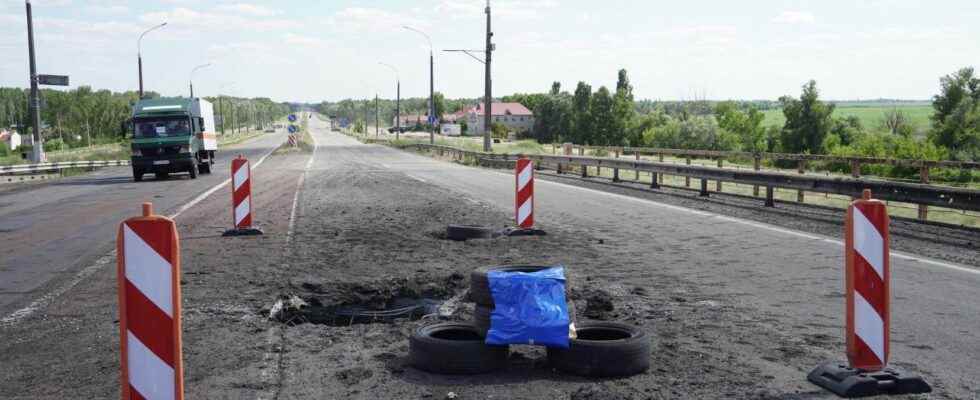Ukraine’s three ports designated for grain exports resumed operation on Wednesday, as the Ukrainian military partially destroyed a strategically important bridge in the Russian-occupied southern region of Kherson and kyiv forces seek to resume.
Ukrainian government expects first shipments to leave Black Sea ports ‘this week’ food around the world.
Again in application of the agreements signed for four months on July 22 in Istanbul, the Joint Coordination Center (CCC) in charge of controlling the transport via the Black Sea of Ukrainian grain was officially inaugurated the same day in this Turkish metropolis.
Another consequence of the Russian offensive, the Nord Stream 1 gas pipeline between Russia and Germany is now only in service, as planned, at around a fifth of its capacity, increasing the risk of shortages this winter in Europe.
Convoys to transport cereals
“The ports of Odessa, Chornomorsk and Yuzhny [Pivdennyi, ndlr] resumed work,” the Ukrainian Navy announced on Wednesday. “The exit and entry of ships to seaports will be done by forming a convoy that will accompany the lead ship,” she continued.
kyiv and Moscow agreed in Istanbul, with the mediation of Turkey and under the aegis of the UN, to allow the delivery abroad of some 25 million tonnes of grain stuck in Ukrainian ports.
However, Ukrainian officials have repeatedly said they do not trust Moscow to ensure the security of convoys and recall the Russian missile fire on Saturday at the port of Odessa.
The Kremlin for its part declared that it did not see any obstacles to the resumption of exports, also hampered by the presence of sea mines laid by Ukrainian forces to guard against a Russian amphibious assault.
Demining will take place only “in the corridor necessary for exports”, stressed kyiv.
Bridge “very damaged”
Spanning the Dnieper in the suburbs of Kherson, the Antonovsky Bridge, a key passage for supplies, was partially disabled on Wednesday by a Ukrainian attack.
This work “is very damaged” and “the Russians do not have the specialists and the equipment to repair it in the short term”, commented the deputy head of the regional council, Yuri Sobolevski, affirming that “the bridge cannot be used to cross heavy military equipment”.
“Those who fired on the bridge just made life a little more difficult for the population,” said Kirill Stremoussov, a senior representative of the Russian occupation authorities.
Kherson is located a few kilometers from the southern front, where the Ukrainian forces launched a counter-offensive in order to reconquer these territories lost in the first days of the Russian assault on Ukraine.
Essential for Ukrainian agriculture, the region is also strategic, as it borders the Crimean peninsula, annexed by Moscow in 2014.
In eastern Ukraine, the Donbass mining basin was the scene of intense fighting. Two people were killed and five injured in the bombardment of a hotel in Bakhmout, announced the Ukrainian emergency services.
AFP journalists present in this city, one of the last in Donbass to remain under Ukrainian control, heard sporadic artillery fire and saw a house hit by a Russian shell. “I was in the barn and was about to go out. I heard a hiss. And I don’t remember anything. It exploded, and I was thrown into the barn” by the blast, Roman, 51, told AFP.
Less Russian gas delivered to Europe
In the context of the energy standoff between Moscow and the West since the start of the conflict, the arrival of gas from Russia in Germany was on Wednesday some 14.4 gigawatt hours (GWh), against nearly 29 GWh on average these last few days, lamented the German operator Gascade, which manages the network on German territory.
The supply of Germany – particularly dependent on Russian gas -, but also of other European countries, via this pipe installed at the bottom of the Baltic Sea had already been reduced to 40% of normal in mid-June, before a stop for annual maintenance between July 11 and 21.
On Monday, Gazprom said it would further halve its daily deliveries via Nord Stream, citing a maintenance operation on a turbine.
A Kremlin spokesman said on Tuesday that the reduction in speed was due to Western sanctions against Russia.
But Europeans accuse Moscow of using gas as an economic and political weapon.
Faced with the risk of a shortage, gas prices continued to rise. On Wednesday morning, the Dutch TTF, the benchmark for natural gas in Europe, had risen by more than 9%. Since the start of the week, the TTF has jumped 35%.
On Wednesday evening, Ukrainian President Volodymyr Zelensky also assured that his country was preparing to increase its electricity exports to the European Union to help Europe “resist energy pressure” from Moscow.
“Our exports allow us not only to increase our foreign exchange earnings, but also to help our partners resist Russian energy pressure,” Zelensky said in his daily video. We will gradually make Ukraine a country guaranteeing Europe’s energy security. »
